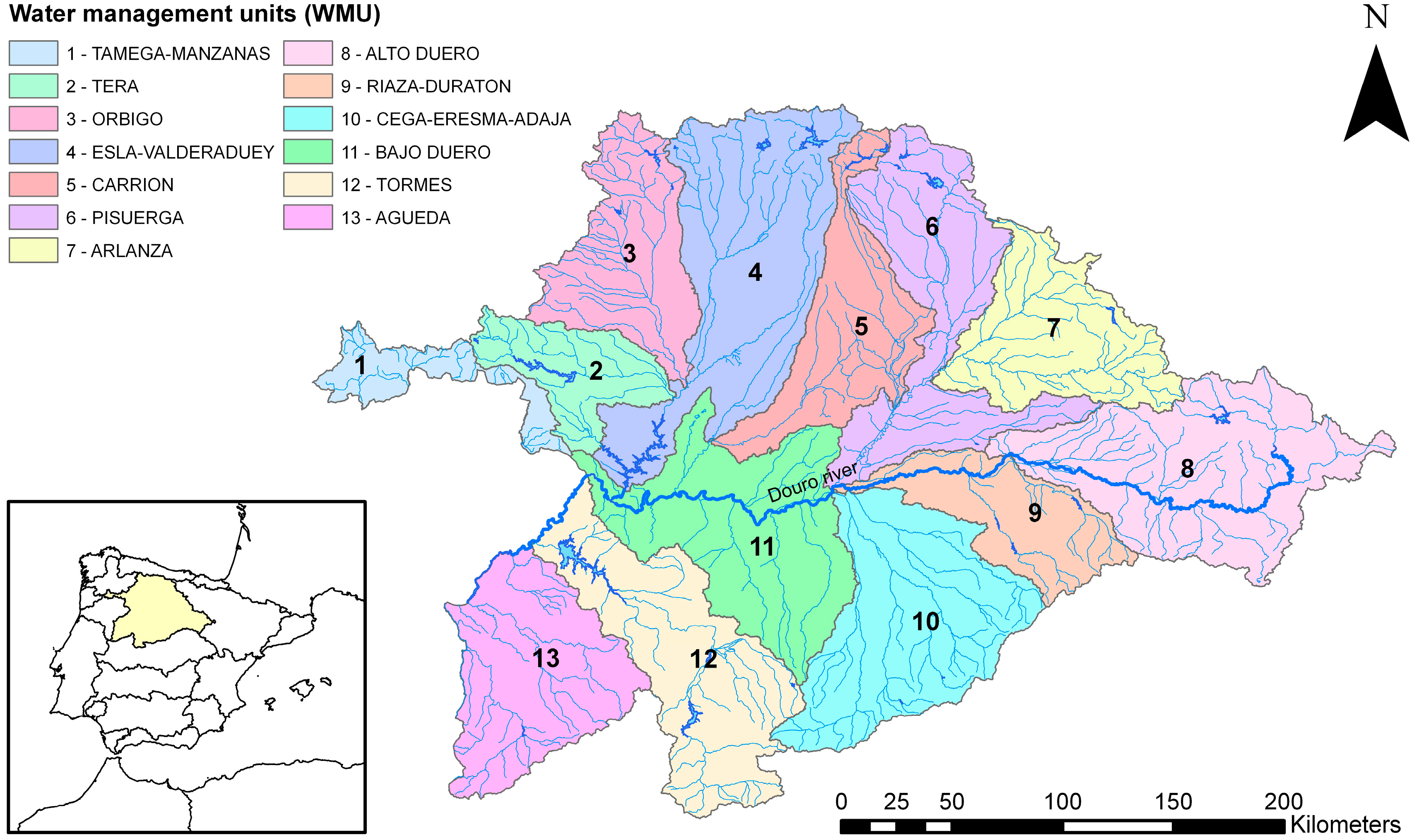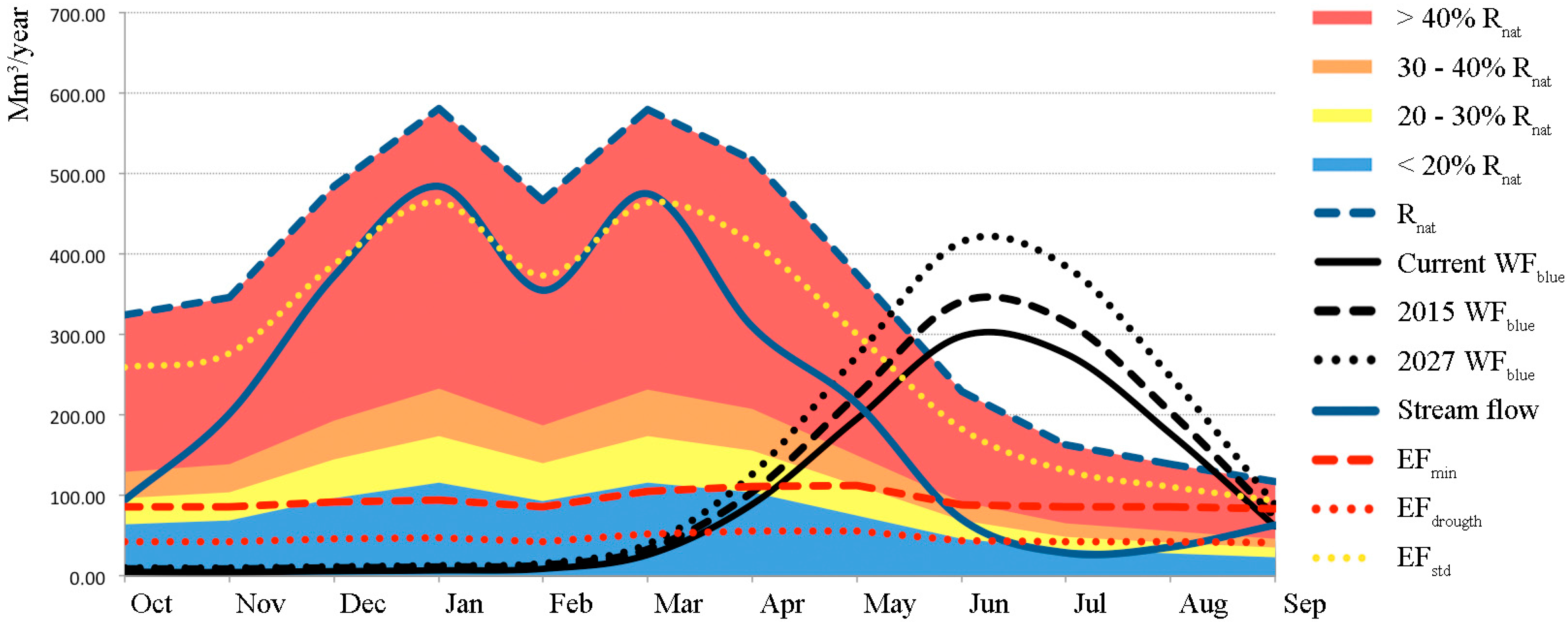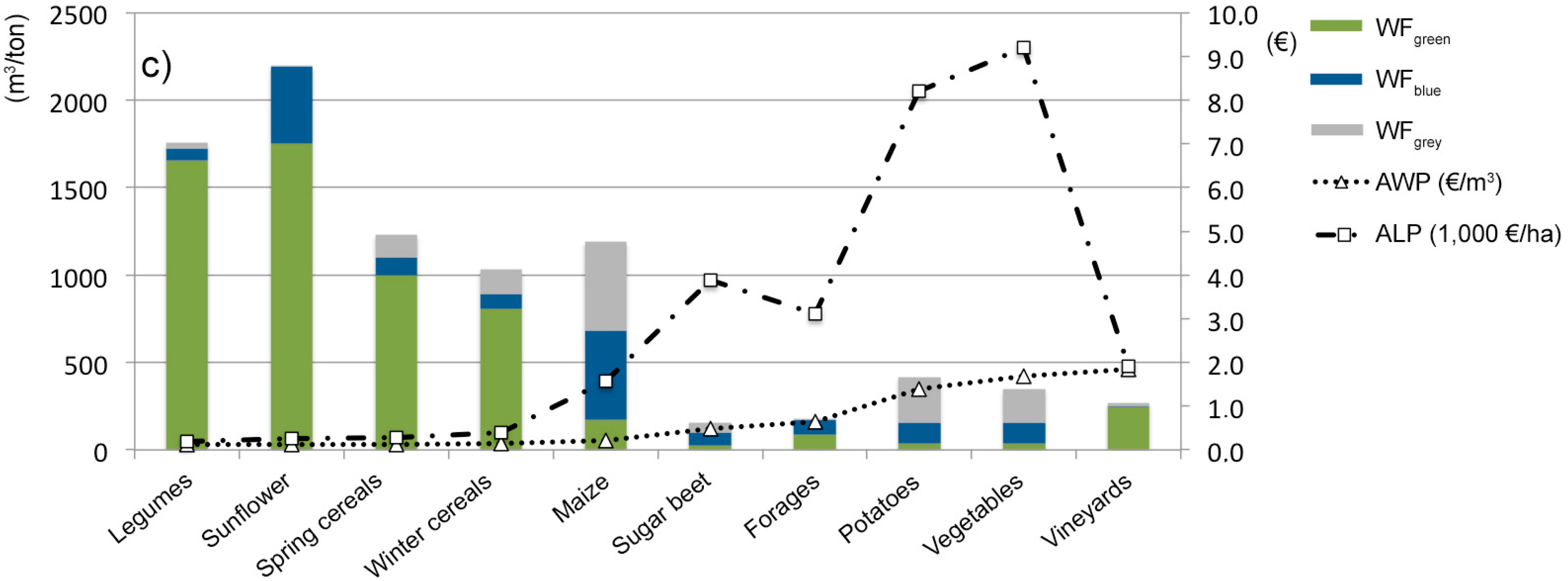The Water Footprint of Agriculture in Duero River Basin
Abstract
:1. Introduction
Study Area: Duero River Basin

2. Materials and Methods
2.1. Modeling Green and Blue Water Consumption
2.2. Modeling the Nitrogen Leaching and Grey Water Footprint
2.3. Harvested Areas
2.4. Sustainability Assessment
3. Results
3.1. The Total Green, Blue and Grey Water Footprint of Crops
| Crops | System | Surface (ha) | Production (1000 tons) | WFgreen (1000 m3) | WFblue (1000 m3) | WFgrey (1000 m3) | WFTotal (1000 m3) |
|---|---|---|---|---|---|---|---|
| Cereals | Rainfed | 1,743,425 | 4720 | 4,095,732 | 0 | 703,999 | 4,799,731 |
| Irrigated | 290,105 | 2024 | 538,545 | 1,129,254 | 815,762 | 2,483,561 | |
| Legumes | Rainfed | 174,728 | 158 | 280,633 | 0 | 3146 | 283,778 |
| Irrigated | 15,963 | 29 | 19,278 | 11,458 | 741 | 31,477 | |
| Potatoes | Rainfed | 1295 | 26 | 2236 | 0 | 5715 | 7951 |
| Irrigated | 19,753 | 779 | 26,850 | 94,557 | 200,513 | 321,920 | |
| Industrial crops | Rainfed | 143,233 | 158 | 255,214 | 0 | 764 | 255,978 |
| Irrigated | 63,425 | 3,714 | 112,614 | 356,327 | 200,308 | 669,248 | |
| Forage | Rainfed | 57,618 | 1045 | 130,462 | 0 | 3093 | 133,555 |
| Irrigated | 32,125 | 1730 | 82,754 | 222,636 | 1608 | 306,998 | |
| Vegetables | Rainfed | 0 | 0 | 0 | 0 | 0 | 0 |
| Irrigated | 8832 | 302 | 11,288 | 36,819 | 60,747 | 108,854 | |
| Vineyards | Rainfed | 58,558 | 236 | 61,007 | 0 | 7878 | 67,211 |
| Irrigated | 2299 | 15 | 1145 | 1315 | 1205 | 2921 | |
| Total | Rainfed | 2,178,857 | 6342 | 4,825,285 | 0 | 724,594 | 5,548,205 |
| Irrigated | 432,502 | 8593 | 792,474 | 1,852,365 | 1,280,883 | 3,924,979 | |
| Total | 2,611,359 | 14,935 | 5,617,760 | 1,852,365 | 2,005,478 | 9,473,184 |

3.2. Blue Water Use, Consumption and Source
3.3. Grey Water Footprint of Nitrogen Application as Fertilizer
| Crops | System | N Application (tons) | N Extract by Crops (tons) | N Leached (tons) | WFgrey | WFgrey | WFgrey 10% |
|---|---|---|---|---|---|---|---|
| (1000 m3) | (m3/ha) | (1000 m3) | |||||
| Cereals | Rain-fed | 119,946 | 96,091 | 7596 | 703,999 | 404 | 1,111,645 |
| Irrigated | 71,009 | 42,623 | 8802 | 815,762 | 2812 | 658,100 | |
| Legumes | Rain-fed | 1319 | 7467 | 34 | 3146 | 18 | 12,221 |
| Irrigated | 815 | 1236 | 8 | 741 | 46 | 7553 | |
| Potatoes | Rain-fed | 293 | 117 | 62 | 5715 | 4414 | 2713 |
| Irrigated | 7912 | 4210 | 2164 | 200,513 | 10,151 | 73,328 | |
| Industrial crops | Rain-fed | 1076 | 5353 | 8 | 764 | 5 | 9976 |
| Irrigated | 19,241 | 15,372 | 2161 | 200,308 | 3158 | 178,319 | |
| Forage | Rain-fed | 877 | 4801 | 33 | 3093 | 54 | 8130 |
| Irrigated | 1107 | 9234 | 17 | 1608 | 50 | 10,261 | |
| Vegetables | Rain-fed | 0 | 0 | 0 | 0 | 0 | |
| Irrigated | 2567 | 1736 | 655 | 60,747 | 6878 | 23,794 | |
| Vineyards | Rain-fed | 897 | 1201 | 85 | 7878 | 135 | 8313 |
| Irrigated | 182 | 75 | 13 | 1205 | 524 | 1687 | |
| Total | Rain-fed | 124,409 | 115,030 | 7818 | 724,594 | 333 | 1,152,999 |
| Irrigated | 102,833 | 74,485 | 13,821 | 1,280,883 | 2962 | 953,042 | |
| Total | 227,242 | 189,515 | 21,639 | 2,005,478 | 768 | 2,106,041 |
3.4. Water Footprint per Ton of Product
3.5. Sustainability of the Blue Water Footprint
| Drainage Basin | Period | Low Stress | Moderate Stress | Significant Stress | Severe Stress | Blue Water Scarcity Index Annual Monthly Average Value | Relation Rnat/WFblue (%) | |||||
|---|---|---|---|---|---|---|---|---|---|---|---|---|
| EFstd | EFeco | EFstd | EFeco | EFstd | EFeco | EFstd | EFeco | EFstd | EFeco | |||
| A95 | Current | 8 | 10 | 0 | 0 | 1 | 0 | 3 | 2 | 1.56 | 0.59 | 14.2% |
| 2015 | 7 | 8 | 0 | 1 | 1 | 1 | 4 | 2 | 2.86 | 1.08 | 26.1% | |
| 2027 | 7 | 8 | 0 | 0 | 1 | 2 | 4 | 2 | 3.16 | 1.20 | 28.8% | |
| A66 | Current | 7 | 9 | 1 | 1 | 0 | 0 | 4 | 2 | 1.91 | 0.67 | 25.9% |
| 2015 | 6 | 9 | 2 | 1 | 0 | 0 | 4 | 2 | 2.22 | 0.77 | 30.2% | |
| 2027 | 6 | 9 | 1 | 0 | 1 | 0 | 4 | 3 | 2.70 | 0.94 | 36.7% | |
| A88 | Current | 9 | 10 | 0 | 2 | 0 | 0 | 3 | 0 | 1.00 | 0.29 | 11.8% |
| 2015 | 7 | 9 | 1 | 1 | 1 | 0 | 3 | 2 | 2.19 | 0.63 | 26.0% | |
| 2027 | 7 | 9 | 1 | 1 | 0 | 0 | 4 | 2 | 2.81 | 0.80 | 33.3% | |

3.6. Apparent Water and Land Productivity

3.7. Sensitivity Analysis

4. Discussion
4.1. Comparison with Other Regional and Global Studies

4.2. Limitation of the Grey Water Footprint Analysis
4.3. Water Footprint Sustainability Assessment
4.4. Implications of the Green and Blue Water Consumption
5. Conclusions
Acknowledgments
Author Contributions
Conflicts of Interest
References
- Hoekstra, A.Y.; Chapagain, A.K.; Aldaya, M.M.; Mekonnen, M.M. The Water Footprint Assesment Manual: Setting the Global Standard; Earthscan: London, UK, 2011. [Google Scholar]
- Konar, M.; Dalin, C.; Suweis, S.; Hanasaki, N.; Rinaldo, A.; Rodriguez-Iturbe, I. Water for food: The global virtual water trade network. Water Resour. Res. 2011, 47. [Google Scholar] [CrossRef]
- Hoekstra, A.Y.; Hung, P.Q. Globalisation of water resources: International virtual water flows in relation to crop trade. Glob. Environ. Chang. 2005, 15, 45–56. [Google Scholar] [CrossRef]
- Zhao, X.; Chen, B.; Yang, Z.F. National water footprint in an input-output framework—A case study of China 2002. Ecol. Model. 2009, 220, 245–253. [Google Scholar] [CrossRef]
- Aldaya, M.M.; Martinez-Santos, P.; Llamas, M.R. Incorporating the water footprint and virtual water into policy: Reflections from the Mancha occidental region, Spain. Water Resour. Manag. 2010, 24, 941–958. [Google Scholar] [CrossRef]
- Mekonnen, M.M.; Hoekstra, A.Y. The green, blue and grey water footprint of crops and derived crop products. Hydrol. Earth Syst. Sci. 2011, 15, 1577–1600. [Google Scholar] [CrossRef]
- Siebert, S.; Dôll, P. Quantifying blue and green virtual water contents in global crop production as well as potential production losses without irrigation. J. Hydrol. 2010, 384, 198–217. [Google Scholar] [CrossRef]
- Liu, J.G. A gis-based tool for modelling large-scale crop-water relations. Environ. Model. Softw. 2009, 24, 411–422. [Google Scholar] [CrossRef]
- Nana, E.; Corbari, C.; Bocchiola, D. A model for crop yield and water footprint assessment: Study of maize in the Po valley. Agric. Syst. 2014, 127, 139–149. [Google Scholar] [CrossRef]
- Xu, C.Y.; Singh, V.P. A review on monthly water balance models for water resources investigations. Water Resour. Manag. 1998, 12, 31–50. [Google Scholar] [CrossRef]
- Liu, J.; Williams, J.R.; Zehnder, A.J.B.; Yang, H. Gepic—Modelling wheat yield and crop water productivity with high resolution on a global scale. Agric. Syst. 2007, 94, 478–493. [Google Scholar] [CrossRef]
- DRBA (Duero River Basin Authority). Hydrological Plan of the Spanish Duero River Basin; Confederation, D.H., Ed.; Ministry of Agriculture, Fishery and Food: Valladolid, Spain, 2012.
- Allen, R.G.; Pereira, L.S.; Raes, D.; Smith, M. Crop evapotranspiration: Guidelines for computing crop water requirements. In Irrigation and Drainage Papers; FAO: Rome, Italy, 1998; Volume 56. [Google Scholar]
- Custodio, E.; Llamas, M.R. Hidrología subterránea; Omega: Barcelona, Spain, 1976. [Google Scholar]
- MAPYA. Timing of Planting, Harvesting and Marketing: 1996–1998 Years; Spanish Ministry of Agriculture Fisheries and Food: Madrid, Spain, 2002.
- AEMET. Meteorological Series on-Line Database; Spanish Meteorological Agency: Madrid, Spain, 2011.
- Panagos, P.; van Liedekerke, M.; Jones, A.; Montanarella, L. European soil data centre: Response to European policy support and public data requirements. Land Use Policy 2012, 29, 329–338. [Google Scholar] [CrossRef]
- United States Department of Agriculture (USDA). Sprinkler irrigation. In National Engineering Handbook; USDA: Washington, DC, USA, 1997. [Google Scholar]
- Álvarez, J.; Sánchez, A.; Quintas, L. SIMPA, a GRASS based tool for hydrological studies. Int. J. Geoinform. 2005, 1, 1. [Google Scholar]
- Wilks, D.S.; Wilby, R.L. The weather generation game: A review of stochastic weather models. Prog. Phys. Geogr. 1999, 23, 329–357. [Google Scholar] [CrossRef]
- Castellvi, F.; Mormeneo, I.; Perez, P.J. Generation of daily amounts of precipitation from standard climatic data: A case study for Argentina. J. Hydrol. 2004, 289, 286–302. [Google Scholar] [CrossRef]
- De Miguel, A.; Kallache, M.; García-Calvo, E. CWUModel: A water balance model to estimate the water footprint in the duero river basin. In Cuadernos de Geomática: La Aplicación de Técnicas Espaciales por la Hidrología Ambiental; Pascual, J.A., Sanz, J.M., de Bustamante, I., Eds.; IMDEA Agua: Madrid, Spain, 2012; Volume 1. [Google Scholar]
- Liden, R.; Harlin, J. Analysis of conceptual rainfall-runoff modelling performance in different climates. J. Hydrol. 2000, 238, 231–247. [Google Scholar] [CrossRef]
- EEC (European Economic Community). Protection of waters against pollution caused by nitrates from agricultural sources, Council Directive 91/676/EEC. Off. J. Eur. Communities 1991, L 375, 1–8. [Google Scholar]
- Liu, C.; Kroeze, C.; Hoekstra, A.Y.; Gerbens-Leenes, W. Past and future trends in grey water footprints of anthropogenic nitrogen and phosphorus inputs to major world rivers. Ecol. Indic. 2012, 18, 42–49. [Google Scholar] [CrossRef]
- Frank, N.A.; Boyacioglu, H.; Hoekstra, A.Y. Grey water footprint accounting: Tier 1, supporting guidelines. In Value of Water Research Report; UNESCO-IHE: Delft, The Netherlands, 2013; Volume nº 65. [Google Scholar]
- Willigen, P.D. An Analysis of the Calculation of Leaching and Denitrification Losses as Practised in the NUTMON Approach; Rapport Plant Research International: Wageningen, The Netherlands, 2000; Volume 18. [Google Scholar]
- Roy, R.N.; Misra, R.V.; Lesschen, J.P.; Smaling, E.M.A. Assesment of soil nutrient balance, approaches and methodologies. In Fertilizer and Plant Nutrition Bulletin; FAO: Rome, Italy, 2003; Volume 14. [Google Scholar]
- MAGRAMA (Spanish Ministry of Agriculture, Livestock and Environment). Nitrogen Balance in the Spanish Agricultural Production; Ministry of Environment and Rural and Marine Affairs: Madrid, Spain, 2012.
- FAO; IIASA; ISRIC; SISSCAS; JRC. Harmonized World Soil Database, 1.2 Version; FAO: Rome, Italy, 2012. [Google Scholar]
- IGN. Occupation of Land Information System in Spain: Technical Paper; National Geographic Institute of Spain: Madrid, Spain, 2011.
- MAGRAMA. Statistical Yearbook of Agriculture on-Line Database; Spanish Ministry of Agriculture Fisheries and Food: Madrid, Spain, 2012.
- INE. Agrarian Census; Spanish National Stastistical Institute: Madrid, Spain, 2012.
- Hoekstra, A.Y.; Mekonnen, M.M.; Chapagain, A.K.; Mathews, R.E.; Richter, B.D. Global monthly water scarcity: Blue water footprints versus blue water availability. PLoS ONE 2012, 7, e32688. [Google Scholar] [CrossRef] [PubMed]
- Richter, B.D.; Davis, M.M.; Apse, C.; Konrad, C. A presumtive standar for environmental flow protection. River Res. Appl. 2012, 28, 1312–1321. [Google Scholar] [CrossRef]
- FAO. Faostat on-Line Database; Food and Agriculture Organization of the United Nations: Rome, Italy, 2014. [Google Scholar]
- Garrido, A.; Llamas, M.R.; Varela-Ortega, C.; Novo, P.; Rodrigez-Casado, R.; Aldaya, M.M. Water Footprint and Virtual Water of Spain; Springer: New York, NY, USA, 2010. [Google Scholar]
- Chapagain, A.K.; Hoekstra, A.Y.; Savenije, H.H.G.; Gautam, R. The water footprint of cotton consumption: An assessment of the impact of worldwide consumption of cotton products on the water resources in the cotton producing countries. Ecol. Econ. 2006, 60, 186–203. [Google Scholar] [CrossRef]
- Portmann, F.T.; Siebert, S.; Döll, P. Mirca2000—Global monthly irrigated and rainfed crop areas around the year 2000: A new high-resolution data set for agricultural and hydrological modeling. Global Biogeochem. Cycles 2010. [Google Scholar] [CrossRef]
- Zhuo, L.; Mekonnen, M.M.; Hoekstra, A.Y. Sensitivity and uncertainty in crop water footprint accounting: A case study for the Yellow River basin. Hydrol. Earth Syst. Sci. 2014, 18, 2219–2234. [Google Scholar] [CrossRef]
- Soriano, M.D.; Pons, V.; Gracía-España, L. Comparación de los valores obtenidos en zonas contrastadas climáticamente en la península ibérica utilizando diferentes modelos para el cálculo de la evapotranspiración. In 8º Congreso Internaciona Cambio Climático. Extremos e Impactos; Asociación Española de Climatología: Salamanca, Spain, 2012; Volume 2. [Google Scholar]
- Racsko, P.; Szeidl, L.; Semenov, M. A serial approach to local stochastic weather models. Ecol. Model. 1991, 57, 27–41. [Google Scholar] [CrossRef]
- Rosegrant, M.W.; Msangi, S.; Ringler, C.; Sulser, T.B.; Zhu, T.; Cline, S.A. International Model for Policy Analysis of Agricultural Commodities and Trade (Impact): Model Description; International Food Policy Research Institute: Washington, DC, USA, 2008. [Google Scholar]
- Lesschen, J.P.; Stoorvogel, J.J.; Smaling, E.M.A.; Heuvelink, G.B.M.; Veldkamp, A. A spatially explicit methodology to quantify soil nutrient balances and their uncertainties at the national level. Nutr. Cycl. Agroecosyst. 2007, 78, 111–131. [Google Scholar] [CrossRef]
- Diez, J.A.; Caballero, R.; Roman, R.; Tarquis, A.; Cartagena, M.C.; Vallejo, A. Integrated fertilizer and irrigation management to reduce nitrate leaching in central Spain. J. Environ. Qual. 2000, 29, 1539–1547. [Google Scholar] [CrossRef]
- Cavero, J.; Beltrán, A.; Aragüés, R. Nitrate exported in drainage waters of two sprinkler-irrigated watersheds. J. Environ. Qual. 2003, 32, 916–926. [Google Scholar] [CrossRef] [PubMed]
- Moreno, F.; Cayuela, J.A.; Fernandez, J.E.; FernandezBoy, E.; Murillo, J.M.; Cabrera, F. Water balance and nitrate leaching in an irrigated maize crop in SW spain. Agric. Water Manag. 1996, 32, 71–83. [Google Scholar] [CrossRef]
- Jego, G.; Martinez, M.; Antiguadad, I.; Launay, M.; Sanchez-Perez, J.M.; Justes, E. Evaluation of the impact of various agricultural practices on nitrate leaching under the root zone of potato and sugar beet using the STICS soil-crop model. Sci. Total Environ. 2008, 394, 207–221. [Google Scholar] [CrossRef] [PubMed] [Green Version]
- Dabrowski, J.M.; Murray, K.; Ashton, P.J.; Leaner, J.J. Agricultural impacts on water quality and implications for virtual water trading decisions. Ecol. Econ. 2009, 68, 1074–1082. [Google Scholar] [CrossRef]
- Ercin, A.E.; Mekonnen, M.M.; Hoekstra, A.Y. Sustainability of national consumption from a water resources perspective: The case study for France. Ecol. Econ. 2013, 88, 133–147. [Google Scholar] [CrossRef]
- ISO. Environmental Management—Water Footprint—Principles, Requirements and Guidelines; ISO 14046; ISO: Geneva, Switzerland, 2014. [Google Scholar]
- Kounina, A.; Margni, M.; Bayart, J.B.; Boulay, A.M.; Berger, M.; Bulle, C.; Frischknecht, R.; Koehler, A.; Canals, L.M.I.; Motoshita, M.; et al. Review of methods addressing freshwater use in life cycle inventory and impact assessment. Int. J. Life Cycle Assess. 2013, 18, 707–721. [Google Scholar] [CrossRef]
- Canals, L.M.I.; Chenoweth, J.; Chapagain, A.; Orr, S.; Anton, A.; Clift, R. Assessing freshwater use impacts in lca: Part I—Inventory modelling and characterisation factors for the main impact pathways. Int. J. Life Cycle Assess. 2009, 14, 28–42. [Google Scholar] [CrossRef]
- Zelm, R.V.; Schipper, A.M.; Rombouts, M.; Snepvangers, J.; Huijbregts, M.A.J. Implementing groundwater extraction in life cycle impact assessment: Characterization factors based on plant species richness for The Netherlands. Environ. Sci. Technol. 2011, 45, 629–635. [Google Scholar] [CrossRef] [PubMed]
- Berger, M.; Finkbeiner, M. Water footprinting: How to address water use in life cycle assessment? Sustainability 2010, 2, 919–944. [Google Scholar] [CrossRef]
- Aldaya, M.M.; Allan, J.A.; Hoekstra, A.Y. Strategic importance of green water in international crop trade. Ecol. Econ. 2010, 69, 887–894. [Google Scholar] [CrossRef]
- Gómez-Limón, J.A. Agua y regadío en el duero. In Congreso Homenaje al Duero y sus Ríos: Memoria, Cultura y Porvenir; Fundación Nueva Cultura del Agua: Salamanca, Spain, 2006. [Google Scholar]
- Mateos, L.; Federes, E.; Losada, A. Eficiencia del riego y modernización de regadíos. In XIV Congreso Nacional de Riegos; Asociación Española de Riegos y Drenajes: Almería, Spain, 1996. [Google Scholar]
- Lopez-Gunn, E.; Zorrilla, P.; Prieto, F.; Llamas, M.R. Lost in translation? Water efficiency in Spanish agriculture. Agric. Water Manag. 2012, 108, 83–95. [Google Scholar] [CrossRef]
- Ward, F.A.; Pulido-Velázquez, M. Water conservation in irrigation can increase water use. Proc. Natl. Acad. Sci. USA 2008, 105, 18215–18220. [Google Scholar] [CrossRef] [PubMed]
- Diaz, J.A.R.; Urrestarazu, L.P.; Poyato, E.C.; Montesinos, P. Modernizing water distribution networks lessons from the Bembezar MD irrigation district, Spain. Outlook Agric. 2012, 41, 229–236. [Google Scholar] [CrossRef]
- Moratiel, R.; Snyder, R.L.; Duran, J.M.; Tarquis, A.M. Trends in climatic variables and future reference evapotranspiration in Duero valley (Spain). Nat. Hazards Earth Syst. Sci. 2011, 11, 1795–1805. [Google Scholar] [CrossRef] [Green Version]
- Ceballos-Barbancho, A.; Morán-Tejeda, E.; Luengo-Ugidos, M.Á.; Llorente-Pinto, J.M. Water resources and environmental change in a Mediterranean environment: The south-west sector of the Duero river basin (Spain). J. Hydrol. 2008, 351, 126–138. [Google Scholar] [CrossRef]
© 2015 by the authors; licensee MDPI, Basel, Switzerland. This article is an open access article distributed under the terms and conditions of the Creative Commons Attribution license (http://creativecommons.org/licenses/by/4.0/).
Share and Cite
De Miguel, Á.; Kallache, M.; García-Calvo, E. The Water Footprint of Agriculture in Duero River Basin. Sustainability 2015, 7, 6759-6780. https://doi.org/10.3390/su7066759
De Miguel Á, Kallache M, García-Calvo E. The Water Footprint of Agriculture in Duero River Basin. Sustainability. 2015; 7(6):6759-6780. https://doi.org/10.3390/su7066759
Chicago/Turabian StyleDe Miguel, Ángel, Malaak Kallache, and Eloy García-Calvo. 2015. "The Water Footprint of Agriculture in Duero River Basin" Sustainability 7, no. 6: 6759-6780. https://doi.org/10.3390/su7066759





